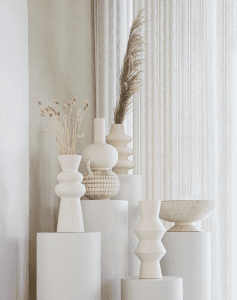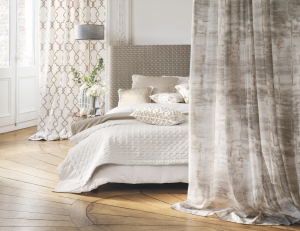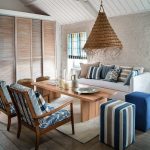Japandi Style:
The Best of Two Design Aesthetics

Japandi style is a fusion of Japanese and Scandinavian design that has been gaining popularity in recent years.
This minimalist design style combines the best of both aesthetics to create a unique look that is both functional and beautiful. The Japanese aesthetic is all about simplicity, harmony, and natural materials. It emphasizes clean lines and uncluttered spaces, using muted colors and natural textures to create a calming atmosphere. Meanwhile, the Scandinavian style is known for its functional design, with a focus on practicality and efficiency. It uses light colors, natural materials, and simple shapes to create a cozy and inviting atmosphere.
Japandi style combines the best of these two aesthetics, resulting in a design that is both elegant and practical. This style is perfect for those who want a calm and minimalist home, but also want to incorporate functional and practical elements. To achieve the Japandi style, there are certain elements that you should consider incorporating into your design.
Color Palette: The color palette in Japandi style is muted and neutral, with a focus on natural tones such as beige, white, black, and grey. This creates a calm and soothing atmosphere that is perfect for relaxation.
Natural Materials: Both Japanese and Scandinavian design favor natural materials such as wood, stone, and bamboo. These materials are used in furniture, flooring, and accessories to bring warmth and texture to the space.
Minimalism: Japandi style is all about simplicity and minimalism. It emphasizes clean lines and uncluttered spaces, with a focus on functionality.
Lighting: Lighting is an important element in Japandi style. Natural light is preferred, with large windows and skylights used to bring in as much light as possible. Soft lighting is also used to create a cozy atmosphere in the evenings.
Accessories: Accessories are used sparingly in Japandi style. When they are used, they are carefully chosen to complement the overall aesthetic. This may include items such as ceramics, pottery, and plants.
Benefits of Japandi Style
Japandi style offers several benefits to homeowners who choose to incorporate it into their homes.
Calming Atmosphere: The muted color palette and natural materials used in Japandi style create a calming atmosphere that is perfect for relaxation and unwinding after a long day.
Functionality: Japandi style emphasizes functionality and practicality, making it perfect for those who want a beautiful home that is also easy to live in.
Timelessness: Japandi style is a timeless design aesthetic that is unlikely to go out of style. This makes it a great investment for homeowners who want a long-lasting design.
Sustainability: Both Japanese and Scandinavian design favor natural materials and a focus on sustainability. By incorporating Japandi style into your home, you are supporting sustainable design practices.
How to Incorporate Japandi Style into Your Home
If you are interested in incorporating Japandi style into your home, there are several ways to do so.
Start with the Color Palette: Begin by choosing a muted color palette that incorporates natural tones such as beige, white, black, and grey.
Emphasize Natural Materials: Choose furniture and accessories that are made from natural materials such as wood, stone, and bamboo.
Focus on Functionality: Choose furniture and accessories that are practical and functional. Avoid clutter and choose pieces that serve a purpose.
Use Lighting Effectively: Use natural light as much as possible, and add soft lighting in the evenings to create a cozy atmosphere.
Choose Accessories Carefully: Choose accessories that complement the overall aesthetic of your Japandi style home. Consider adding items such as ceramics, pottery, and plants to add texture and warmth to the space.
Incorporate Japanese and Scandinavian Design Elements: Consider incorporating design elements from both Japanese and Scandinavian design, such as sliding doors and clean lines.
Simplify Your Space: Japandi style is all about simplicity and minimalism, so simplify your space by getting rid of unnecessary clutter and choosing only the essentials.
Japandi Style in Different Rooms
Japandi style can be incorporated into different rooms of your home, each with its own unique approach.
Living Room: In the living room, focus on creating a cozy and inviting atmosphere with comfortable seating and soft lighting. Incorporate natural materials such as wood and stone, and add accessories such as plants and pottery.
Bedroom: In the bedroom, prioritize relaxation and simplicity. Choose a muted color palette and soft lighting, and incorporate natural materials such as cotton and linen. Opt for simple, functional furniture that creates a sense of calm.
Kitchen: In the kitchen, choose functional and practical pieces such as wooden cutting boards and ceramic dishes. Keep the space uncluttered and use natural materials such as wood and stone.
Bathroom: In the bathroom, focus on creating a spa-like atmosphere with natural materials such as wood and stone. Choose simple, clean lines for your fixtures and accessories, and incorporate soft lighting.
Japandi In Brief Words
In conclusion, Japandi style is a beautiful and practical design aesthetic that combines the best of Japanese and Scandinavian design. By incorporating natural materials, muted colors, and functional pieces into your home, you can create a calming and timeless space that is both beautiful and easy to live in. Whether you are looking to redesign your entire home or just want to incorporate a few elements of Japandi style, this design aesthetic is sure to bring a sense of peace and harmony to your space.
We hope you have enjoyed this article!
Estefani Batista
Partner – Interior Designer
(+34) 637 493 356
(+34) 952 130 841
Centro Comercial Guadalmina IV, Local 92, primera planta.
29670, Guadalmina Alta, Marbella.





